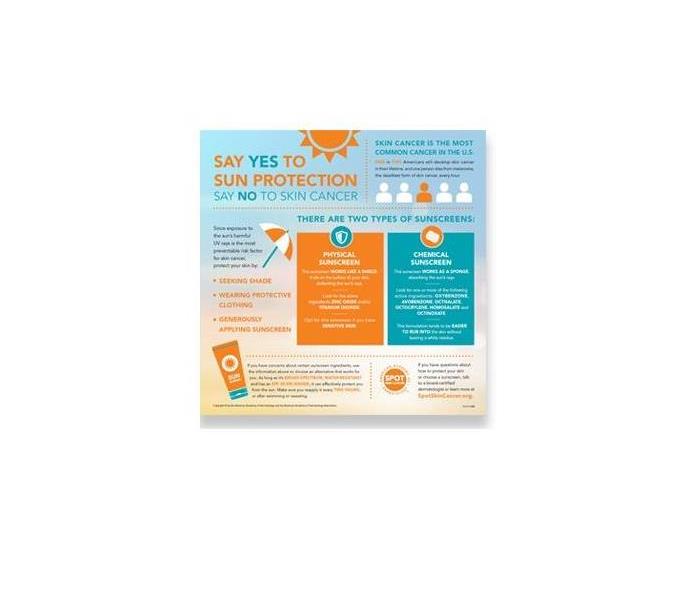Part 1: May is Skin Cancer Awareness Month
5/13/2019 (Permalink)
UV exposure is the most preventable risk factor for skin cancer. During Skin Cancer Awareness Month, the American Academy of Dermatology is asking "Do You Use Protection?"
And is encouraging you to practice safe sun every time you are outdoors. Seek shade, wear protective clothing, and use a broad-spectrum, water-resistant sunscreen with SPF 30+ to reduce your risk.
Follow these tips to protect your skin from the sun's damaging ultraviolet rays and reduce your risk of skin cancer:
A tan is a sign that your skin has been injured. Whether you’re exposed to the sun’s UV rays or visit an indoor tanning salon, every time you tan, your skin is damaged. As this damage builds, you speed up the aging of your skin and increase your risk for all types of skin cancer, including melanoma, the deadliest form of skin cancer.
How to select a sunscreen
Do you know that some sunscreens can prevent sunburn, reduce your risk of getting skin cancer, and help prevent early signs of skin aging?
How you apply your sunscreen also affects how well it protects you. You can find out how to get the most protection from your sunscreen by watching the Academy’s video “How to apply sunscreen”.
How to apply sunscreen
Sunscreen is safe and can protect your skin against skin cancer and premature aging. However, it is not as effective unless it's applied correctly. Follow these tips from dermatologists when applying sunscreen:
- Choose a sunscreen that has an SPF of 30 or higher, is water resistant, and provides broad-spectrum coverage, which means it protects you from UVA and UVB rays. Follow these helpful tips when selecting a sunscreen.
- Apply sunscreen generously before going outdoors. It takes approximately 15 minutes for your skin to absorb the sunscreen and protect you. If you wait until you are in the sun to apply sunscreen, your skin is unprotected and can burn.
- Apply enough sunscreen to cover all exposed skin. Most adults need about 1 ounce — or enough to fill a shot glass — to fully cover their body. Rub the sunscreen thoroughly into your skin.
- Apply sunscreen to all bare skin. Remember your neck, face, ears, tops of your feet and legs. For hard-to-reach areas like your back, ask someone to help you or use a spray sunscreen. If you have thinning hair, either apply sunscreen to your scalp or wear a wide-brimmed hat. To protect your lips, apply a lip balm with a SPF of at least 15.
- To remain protected when outdoors, reapply sunscreen every two hours, or immediately after swimming or sweating. People who get sunburned usually didn't use enough sunscreen, didn't reapply it after being in the sun, or used an expired product. Your skin is exposed to the sun's harmful UV rays every time you go outside, even on cloudy days and in the winter. So whether you are on vacation or taking a brisk fall walk in your neighborhood, remember to use sunscreen. For more skin cancer prevention tips, see a board-certified dermatologist.
People who get sunburned usually didn't use enough sunscreen, didn't reapply it after being in the sun, or used an expired product.
Your skin is exposed to the sun's harmful UV rays every time you go outside, even on cloudy days and in the winter. So whether you are on vacation or taking a brisk fall walk in your neighborhood, remember to use sunscreen.
For more skin cancer prevention tips, see a board-certified dermatologist.






 24/7 Emergency Service
24/7 Emergency Service
